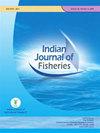The impact of COVID 19 pandemic on marine fisheries sector: A case study from Andhra Pradesh, India
IF 0.3
4区 农林科学
Q4 FISHERIES
引用次数: 0
Abstract
This study discusses the impact of first and second waves of the COVID-19 pandemic on marine fisheries sector of Andhra Pradesh, India, covering the aspects of active fishing days, perception on reduction or enhancement of demand for fish, trends in price realisation, challenges encountered in marketing the fish, perceptions on government interventions as well as changes in socio-behavioural issues. The study was conducted during the period from June to September 2021, among a sample of 152 stakeholders involved in fishing and allied activities from Srikakulam, Vizianagaram, Visakhapatnam, East Godavari and Krishna districts in Andhra Pradesh. Average number of active fishing days in a month was found to be 11.44 during the first wave and 15.10 during the second wave periods. Nearly three-fourth of the respondents (73.68%) perceived that there was reduction in demand for fish during the first wave of the pandemic, and it was to the tune of 40%. Reduction in the daily earnings was reported to the tune of 37.09%. The challenges encountered in marketing the fish were, getting export orders, access to market, availability of storage, transportation and logistics. Peer interaction, time spent with family members and time spent in social media were higher than usual during both waves of the pandemic. Changes or disruptions in usual marketing channels were reported during both the periods. Satisfied perception was expressed on government interventions such as ration, timely advisories, health care and sanitary measures. A few positive impacts on fisheries observed during the pandemic were product innovations, new distribution channels such as online marketing, e-commerce and home deliveries, shortening of supply chains including elimination of auction at fishing harbour, lowering of ocean pollution as well as government reforms. From the results of the study, we propose socio-economic interventions to be taken up by concerned governments for ensuring that the impact of the pandemic is mitigated and also that any future pandemic can have minimal impacts on the fishing community. Keywords: Export market, Livelihood, Lockdown, Nutritional security, Policy interventions, Socio-behavioural issues, Supply chains2019冠状病毒病大流行对海洋渔业的影响:以印度安得拉邦为例
本研究讨论了第一波和第二波2019冠状病毒病大流行对印度安得拉邦海洋渔业部门的影响,涵盖捕鱼活跃日、对鱼品需求减少或增加的看法、价格实现趋势、鱼品营销遇到的挑战、对政府干预的看法以及社会行为问题的变化。该研究于2021年6月至9月期间在安得拉邦的Srikakulam, Vizianagaram, Visakhapatnam,东戈达瓦里和克里希纳地区参与渔业和相关活动的152名利益相关者的样本中进行。在第一波和第二波期间,平均每月活跃捕鱼日数分别为11.44天和15.10天。近四分之三的答复者(73.68%)认为,在大流行的第一波期间,对鱼的需求减少了,这一比例约为40%。据报道,每日收入减少了37.09%。在销售鱼类时遇到的挑战是,获得出口订单、进入市场、储存、运输和物流的可用性。在两波大流行期间,同伴互动、与家庭成员相处的时间以及在社交媒体上花费的时间都高于平时。在这两个期间,通常的销售渠道都发生了变化或中断。与会者对定量配给、及时通报、保健和卫生措施等政府干预措施表示满意。大流行期间观察到的对渔业的一些积极影响是产品创新、新的分销渠道(如在线营销、电子商务和送货上门)、缩短供应链(包括取消渔港拍卖)、减少海洋污染以及政府改革。根据研究结果,我们建议有关政府采取社会经济干预措施,以确保减轻大流行病的影响,并确保未来任何大流行病对渔业社区的影响最小。关键词:出口市场,生计,封锁,营养安全,政策干预,社会行为问题,供应链
本文章由计算机程序翻译,如有差异,请以英文原文为准。
求助全文
约1分钟内获得全文
求助全文
来源期刊

Indian Journal of Fisheries
FISHERIES-
CiteScore
0.90
自引率
20.00%
发文量
0
审稿时长
6-12 weeks
期刊介绍:
Indian Journal of Fisheries is published quarterly by the Indian Council of Agricultural Research (ICAR), New Delhi. Original contributions in the field of Fish and fisheries science are considered for publication in the Journal. The material submitted must be unpublished and not under consideration for publication elsewhere.
Papers based on research which kills or damages any species, regarded as thratened/ endangered by IUCN crieteria or is as such listed in the Red Data Book appropriate to the geographic area concerned, will not be accepted by the Journal, unless the work has clear conservation objectives.
 求助内容:
求助内容: 应助结果提醒方式:
应助结果提醒方式:


